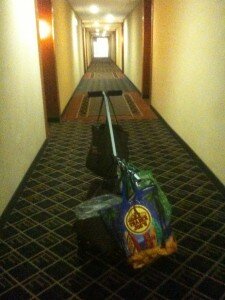logistics matter: you have to get the food home before you can get it on the table
 One thing that I often find public health/food activist folks don't have much imagination for is the reality of getting food into the home, not just getting it on the table. It's one thing to say, "eat 5 servings of organic, local fruits and veggies!" and, "get thee to a farmer's market!" But, the reality is, not all families own a min-van, have a covered garage, week-end mornings free to wander among the stalls at the market, or even a large fridge and freezer to store foods etc. When we blame parents for making kids fat or skinny, and admonish parents to shop and cook organics when most Americans live in a fresh food dessert, when 1/6 Americans now live below the poverty level (with a higher proportion of children), when soda costs a fraction of what organic milk does, we are often missing the picture, and missing the opportunity to affect change.I got a glimpse of the logistical issues in a personal way when we sold our 100 year-old high-maintenance home, with garage and moved into a rental town-home apartment building (which we are loving more than we thought we would and are in no rush to look for another home...) It took some time to figure out a system.Anyway, shopping looks very different here. We park underground (YAY! No more shoveling!) and I quickly realized that my typical 4-6 bag shopping trips for my family of three now proposed certain challenges. We have a VERY long hallway on the fourth floor, and short of making three trips in our slow elevator, I had to figure out how to get the groceries to our door. So I looked online and found this cart, that cost about $35 (I can't find the link, it's from Designs We Need...) Even then, I have to have cloth bags to fit it, paper bags have ripped, spilling contents on the garage, I have overloaded and bent the cart by trying to roll over an unseen shoe, and buying a replacement would not be a hardship (though it seems to be fine bent back in shape). I also wonder about families with more kids, and growing teens, if I have 4-6 bags easily, per week, how much more food are those families schlepping around?So, the next time you see a high-rise, or a small rural community, think about how you would shop if you had to take your small child or children with you because you can't afford childcare, or maybe you have to shop after work, at 8 pm, with kids in tow. Maybe you don't have a car– so now try this on a bus, then think about getting those bags on the bus, and your kids, and all of them to the door, if you were able to get to a grocery store.Just saying it's something we should think about, and many of us who extol the virtues of back-yard garden plots, and organic milk and grass-fed meat might not spend enough time thinking about this. Many of our policy makers don't think about it either... Maybe we can honor what parents are trying to do. Honor frozen and canned foods, honor as a culture the family dinner hour. Work towards decreasing poverty, making childcare more accessible, meeting families where they are in terms of family meals and food choices, subsidizing food items like milk and fresh foods, instead of just focusing on taxing "junk" food, continuing programs that increase the reach of farmers' markets and making the foods there accessible with food assistance programs... Just a start.What say you? How has your living arrangement over the years, from logistics to money to childcare shaped what you have been able to eat? What solutions have you found?
One thing that I often find public health/food activist folks don't have much imagination for is the reality of getting food into the home, not just getting it on the table. It's one thing to say, "eat 5 servings of organic, local fruits and veggies!" and, "get thee to a farmer's market!" But, the reality is, not all families own a min-van, have a covered garage, week-end mornings free to wander among the stalls at the market, or even a large fridge and freezer to store foods etc. When we blame parents for making kids fat or skinny, and admonish parents to shop and cook organics when most Americans live in a fresh food dessert, when 1/6 Americans now live below the poverty level (with a higher proportion of children), when soda costs a fraction of what organic milk does, we are often missing the picture, and missing the opportunity to affect change.I got a glimpse of the logistical issues in a personal way when we sold our 100 year-old high-maintenance home, with garage and moved into a rental town-home apartment building (which we are loving more than we thought we would and are in no rush to look for another home...) It took some time to figure out a system.Anyway, shopping looks very different here. We park underground (YAY! No more shoveling!) and I quickly realized that my typical 4-6 bag shopping trips for my family of three now proposed certain challenges. We have a VERY long hallway on the fourth floor, and short of making three trips in our slow elevator, I had to figure out how to get the groceries to our door. So I looked online and found this cart, that cost about $35 (I can't find the link, it's from Designs We Need...) Even then, I have to have cloth bags to fit it, paper bags have ripped, spilling contents on the garage, I have overloaded and bent the cart by trying to roll over an unseen shoe, and buying a replacement would not be a hardship (though it seems to be fine bent back in shape). I also wonder about families with more kids, and growing teens, if I have 4-6 bags easily, per week, how much more food are those families schlepping around?So, the next time you see a high-rise, or a small rural community, think about how you would shop if you had to take your small child or children with you because you can't afford childcare, or maybe you have to shop after work, at 8 pm, with kids in tow. Maybe you don't have a car– so now try this on a bus, then think about getting those bags on the bus, and your kids, and all of them to the door, if you were able to get to a grocery store.Just saying it's something we should think about, and many of us who extol the virtues of back-yard garden plots, and organic milk and grass-fed meat might not spend enough time thinking about this. Many of our policy makers don't think about it either... Maybe we can honor what parents are trying to do. Honor frozen and canned foods, honor as a culture the family dinner hour. Work towards decreasing poverty, making childcare more accessible, meeting families where they are in terms of family meals and food choices, subsidizing food items like milk and fresh foods, instead of just focusing on taxing "junk" food, continuing programs that increase the reach of farmers' markets and making the foods there accessible with food assistance programs... Just a start.What say you? How has your living arrangement over the years, from logistics to money to childcare shaped what you have been able to eat? What solutions have you found?
